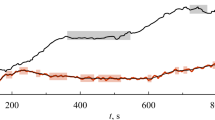Abstract
The dynamic behavior of changes in heart period in response to changes in frequency of supramaximal electrical stimulation of either pre- or postganglionic cardiac sympathetic nerves in five chloralosed cats pretreated with methyl atropine was investigated using time domain techniques. The typical response to step changes in frequency of stimulation (range 1–10 Hz) was found to be a decrease in heart period which reached a steady value after a short delay and was followed, after the stimulus was removed, by a slower return to prestimulus values. No significant difference was found between the responses to pre- and postganglionic stimulation although the strength of the stimuli required to achieve the same response was greater for postganglionic stimulation. Both the observed dynamic and steadystate responses were described to a good approximation by a first-order nonlinear system. The asymmetry in the response was accounted for by including in the model a second-order chemical reaction. The observed delay was accounted for by including a pure time delay. These results suggest that models proposed by previous investigators were unnecessarily complex.
Similar content being viewed by others
References
Bezold, A. von.Untersuchungen über die Innervation des Herzens. Leipzig; Engelmann 1863, Pp. 122–129.
Chess, G. F., and Calaresu, F. R. Frequency response model of vagal control of heart rate in the cat.American Journal of Physiology 1971,220, 554–557.
Chess, G. F., and Calaresu, F. R. A mathematical model of the vagus-heart period system in the cat.IEEE Transactions on Biomedical Engineering 1974,21, 21–27.
Draper, N. R., and Smith, H.Applied regression analysis. New York: John Wiley and Sons, 1966, Pp. 26–32.
Green, J. H., and Heffron, P. F. The inter-relationship between sympathetic activity and the heart rate.Archives Internationales de Pharmacodynamie et de Thérapie 1967,169, 15–25.
Henry, J. L., and Calaresu, F. R. Distribution of cardioacceleratory sites in intermediolateral nucleus of the cat.American Journal of Physiology 1972,222, 700–704.
Kuno, M. Quantum aspects of central and ganglionic synaptic transmission in vertebrates.Physiological Review 1971,51, 647–678.
Liddell, E. G. T., and Sherrington, C.Mammalian physiology: A course of practical exercises. Oxford: Clarendon Press, 1929. Pp. 56–62.
Randall, W. C., and Kelso, A. F. Dynamic basis for sympathetic cardiac augmentation.American Journal of Physiology 1960,198, 971–974.
Randall, W. C., and Rohse, W. G. The augmentor action of the sympathetic cardiac nerves.Circulation Research 1956,4, 470–475.
Reid, M. H., and Mackay, R. S. A review and discussion of some methods for system identification and modeling.Medical and Biological Engineering 1968,6, 231–268.
Rosenbleuth, A., and Simeone, F. A. The interrelations of vagal and accelerator effects on the cardiac rate.American Journal of Physiology 1934,110, 42–55.
Samaan, A. The antagonistic cardiac nerves and heart rate.Journal of Physiology 1935,83, 332–340.
Walpole, R. E., and Myers, R. H.Probability and statistics for engineers and scientists. New York: Macmillan Company, 1972.
Warner, H. R., and Cox, A. A mathematical model of heart rate control by sympathetic and vagus efferent information.Journal of Applied Physiology 1962,17, 349–355.
Warner, H. R., and Russell, R. O. Effect of combined sympathetic and vagal stimulation on heart rate in the dog.Circulation Research 1969,24, 567–573.
Author information
Authors and Affiliations
Rights and permissions
About this article
Cite this article
Chess, G.F., Varey, D.W., Henry, J.L. et al. A mathematical model of the sympathetic-heart period system in the cat. Ann Biomed Eng 3, 189–198 (1975). https://doi.org/10.1007/BF02363070
Received:
Issue Date:
DOI: https://doi.org/10.1007/BF02363070




